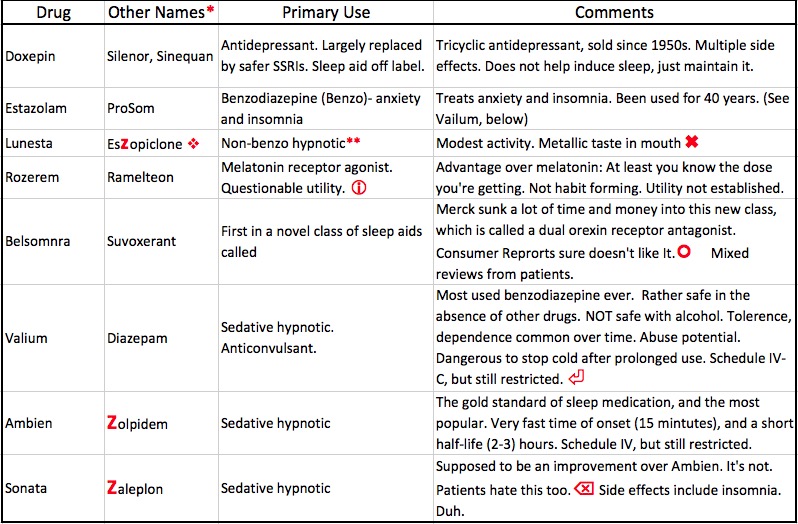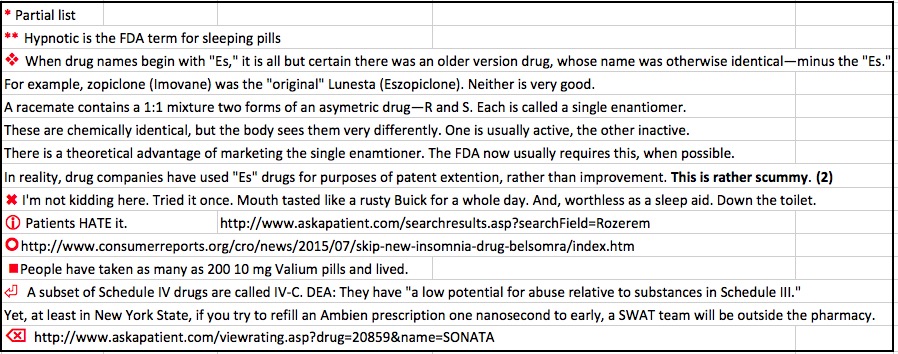
Paradoxical musing:
Let's say that you are an insomniac. Perhaps, after a particularly bad night, the next morning you fall asleep driving to work and have an accident. Depending on where you live, you could lose your license for having insomnia.
So, you see your doctor and he prescribes a sleeping pill. Except when you try to pick it up, you can't get it because you don't have a driver's license, which is needed for identification whenever you pick up controlled substances. How are you going to get around that one? Beats me.
Anyhow, the purpose here is to inform, not complain. When is comes to prescription sleep aids, there are a number of choices. The need for a sleeping pill that is not a member of the benzodiazepine (Valium) class of sedative hypnotics (1) spurred a significant effort to find something different. It worked. In 1992, Sanofi-Aventis hit the jackpot when Ambien (generic name: zolpidem), received FDA approval. It remains the most popular prescription sleeping pill today. Other companies went after their own versions, but with only modest success. They all had "Z" names, so this class of sleep aids is often referred to as the Z's (see table).

Properties of selected prescription sleep aids.
The above table is not comprehensive, nor is it an attempt to present voluminous data on each medicine. It is intended as a quantitative guide. Although far from a scientific analysis, the website Ask A Patient, which I have used, is quite useful, especially when a particular drug is reviewed by a large number of patients. For example, Ambien, the most popular prescription aid, is rated 3.9 on a scale of 5. This is quite good. On the other hand, the subsequent "Z drugs," Zaleplon (3) is rated 2.7—pretty bad (One of its side affects is insomnia. Nice.) If you also read the users' comments, Ask A Patient is even more useful, certainly more so than TV ads and 40-page package inserts.
You will note that the table above indicates multiple comments, which are shown below. In many cases, they are more useful than the chart itself.

Assuming this didn't put you to sleep, or the presidential debates didn't help you relax, some of these work rather well. Or maybe too well, and you'll wake up find that you've become a Nepalese Sherpa who is 18,000 feet up from the base camp of Everest. And perhaps the thong underwear isn't working out all that well.
Notes:
(1) Sedatives are for anxiety. Hypnotics are sleep aids. They are often interchangeable. Benzodiazepines are good sleep aids, however, people can be dependent upon them. This was the driving force behind discovery efforts to come up with an alternative class.
(2) Most people who criticize drug companies have no idea what they're talking about. But, one legitimate criticism is the practice of getting a new patent by making a single enantiomer version of a formerly racemic drug. There is rarely much advantage, except for the company. Perhaps the most egregious example of this is the fact that the heartburn drug Nexium even existed. Nexium is nothing more than the single (active) enantiomer of Prilosec. The result: The dose of Nexium is half that of Prilosec, since the inactive component is gone. Also gone is the $48 billion that people spent on the drug between 2006 and 2012, when the far less expensive (and equally effective Prilosec) would have done just fine.
(3) Zaleplon was invented and developed by Wyeth, a bad sign on a good day. Although it is not often used (because it sucks), at least it didn't kill anyone (probably). Let's call this one a wash.


